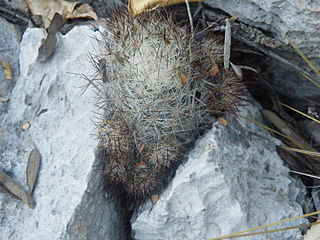
Pelecyphora, pincushion cactus or foxtail cactus is a genus of cacti, comprising 20 species.They originate from Mexico and the United States.

Pelecyphora missouriensis, the Missouri foxtail cactus and formerly Coryphantha missouriensis, is a species of low-growing North American cacti.

Pelecyphora vivipara is a species of cactus known by several common names, including spinystar, viviparous foxtail cactus, pincushion cactus and ball cactus. It is native to North America, where certain varieties can be found from Mexico to Canada. Most of these varieties are limited to the Mojave and Sonoran Deserts. The species epithet "vivipara" is due to the species' viviparous reproductive habit.

Pelecyphora minima is a rare species of cactus known by the common names Nellie cory cactus, Nellie's pincushion cactus, birdfoot cactus, and others. It is a very popular species among cactus collectors. This is one reason why it is a highly endangered species in the wild today. This cactus is found only in Brewster County, Texas, in the United States, where there are three populations remaining near Marathon. The cactus is limited to one outcrop in the Marathon Uplift, where it grows in rocky novaculite soils. It was added to the endangered species list in 1979.

Pelecyphora sneedii is a rare species of cactus known by the common names Sneed's pincushion cactus and carpet foxtail cactus.

Lophocereus schottii, the senita cactus, is a species of cactus from southern Arizona and north-western Mexico, particularly Baja California and Sonora.

Pelecyphora macromeris, the nipple beehive cactus, is a species of cactus in the United States and Mexico. In the Chihuhuan Desert, it is common and has a wide range.

Pelecyphora tuberculosa, the corncob cactus, is a species of flowering plant in the family Cactaceae, native to the south-central United States, and northern Mexico.

Cephalocereus euphorbioides is a species of Cephalocereus from Mexico.

Pelecyphora alversonii commonly known as cushion foxtail cactus or cushion fox-tail cactus, is a species of flowering plant in the family Cactaceae, native to the southwestern United States.

Pelecyphora chihuahuensis is a species of flowering plant in the family Cactaceae, native to Mexico.

Pelecyphora cubensis is a species of flowering plant in the family Cactaceae, native to Cuba.

Pelecyphora laredoi is a species of flowering plant in the family Cactaceae, native to Mexico.

Pelecyphora hesteri is a species of flowering plant in the family Cactaceae, native to Texas, United States.

Pelecyphora emskoetteriana is a species of flowering plant in the family Cactaceae, native to the Mexico and southern United States.
Pelecyphora zilziana is a species of flowering plant in the family Cactaceae, native to Mexico.

Pelecyphora lloydii is a species of flowering plant in the family Cactaceae, native to Mexico.
Pelecyphora duncanii is a species of flowering plant in the family Cactaceae, native to the southern United States.
Pelecyphora abdita is a species of flowering plant in the family Cactaceae, native to the Mexico.

Pelecyphora robbinsiorum known by the common names Cochise pincushion cactus and Cochise foxtail cactus is a species of flowering plant in the family Cactaceae.


















